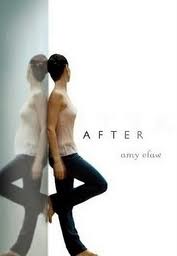 They say that you can’t judge a book by it’s cover. This time, though, the cover was the reason why I decided to pick up After, flip it over, and find out what it was about. It shows a teenager with her hair pulled back in a bun, who is wearing sweatpants and leaning up against a wall.
They say that you can’t judge a book by it’s cover. This time, though, the cover was the reason why I decided to pick up After, flip it over, and find out what it was about. It shows a teenager with her hair pulled back in a bun, who is wearing sweatpants and leaning up against a wall.
Except, it isn’t exactly a wall she is leaning on. It’s more like a mirror, that shows her reflection. Look closely, and you will notice that the mirror image teenager appears to be pregnant. The visual was compelling enough for me to want to find out the whole story.
Flipping open the book (I had picked up the hardcover version) my eyes scanned over the inner dust jacket. A phrase jumped out: Who would leave her own baby in the trash to die? The story (which is fiction) attempts to not only answer that question, but also to explain the motivation that leads some young women to make that choice.
Devon Davenport is a teenager who gets straight A’s in school, and who excels at soccer. She manages this despite the fact that she is what we used to call a “latch key kid” back in the day. Her mother works nights and returns home in the morning after Devon has already left for school. Devon’s father is absent from her life.
The book begins with a scene where Devon is on the couch, under a blanket, staring at the TV while floating and in and out of consciousness. Her mother comes home from work, and is confused to find Devon there. She notes that Devon never stays home from school, and assumes that she must be sick. Instead of tending to her daughter, Devon’s mother wants to talk about something she saw outside. Police had blocked off the alley near the trash and were gathering evidence. Somebody left a baby in the trash!
It doesn’t take long before the police knock on the door. They are looking for people who might know something about the mother of the abandoned baby. Soon, it is discovered that Devon is bleeding profusely from between her legs. She is rushed to the hospital and examined (while delirious and fighting against it) and the doctor determines that Devon had recently given birth. The placenta was still inside her body.
Not long after treatment, Devon finds herself handcuffed and in the back of a police car being driven to her court date. On the way, they pass a church and Devon reads the church sign. Combine this with the bible quote that was placed at the front of the book… and I was suspicious that I’d picked up a book that was going to basically chastise Devon (and, by extension, all teens who get pregnant) for not waiting until marriage to have sex.
Devon has blocked out almost all of the birth and absolutely all of the events that led to her getting pregnant. As a reader, we don’t know if Devon got pregnant after spending the night with a long-term, amazing, boyfriend, or if she was raped. I honestly considered forgetting about this book early on because I could not stomach the thought of reading what would amount to a rant that blames a rape victim for getting pregnant, and at the same time, attempts to shame her for not doing the Christian thing and remaining a virgin until after marriage. Fortunately, that isn’t how this book is presented at all!
Instead, the book follows Devon as she is booked in what amounts to a juvenile prison situation and attempts to cope with her experiences while there. Small pieces of her memory come back, over time (with much coaxing from her attorney). Devon’s memory loss results in a technique I’ve heard called “the unreliable narrator”. The main character is unable to fully reveal important parts of the story (for a while). It was interesting to watch the pieces fall into place. By the end, the reader is able to find out the whole story. The ending isn’t quite what I expected, but it works.
The book is very clearly meant for a teen audience. There is a writing style that some teen books take on that this book matches. I wouldn’t say it was “dumbed down”, rather that it was written in a way that teenagers would find easy to relate to. After would appeal to teenage girls (but I doubt most teenage boys would seek it out).
Devon was pregnant, and blocking out the symptoms. She gives birth alone without the help of doctors or nurses. There are many descriptions of how her body feels after this experience. Her breasts are sore and she becomes embarrassed because she is lactating and it shows on her clothing. She bleeds through several hospital sized sanitary napkins and is mortified to have to ask for more of them while in the juvenile prison. Teenage guys might be interested in reading about the intimate details of the female body, but not when they are presented this way.
Teenage girls, on the other hand, might be seeking out exactly this sort of information (even if it is presented in a fiction book). I can see where a teen who suspects she might be pregnant would pick up this book. There is potential that the book could dissuade some teens from abandoning their newborns in a bathroom or dumpster, simply by pointing out the potential consequences of doing so. Look what happened to Devon!
Other teens may want to explore this controversial topic without starting a conversation about it with her parents (who might presume the teen is asking about the topic because she is already pregnant). All of this can be helpful.
My biggest concern with this book, however, is that I believe the descriptions of pregnancy, childbirth, and what can happen to women’s bodies as a result of childbirth, may scare the hell out of teens who have not been given adequate information about the subject in school or from their parents. It worries me that a teen will pick up this book because she wants to learn about what it is like to be pregnant and to give birth, will be presented with a graphic, painful, terrifying description of it as her first example.
This is not to say that I think the author is at fault for presenting her story this way, or that she should be responsible for teaching Sexual Education to teenagers. I just worry about the impact something like this could have on an incredibly innocent teen who has no resources with which to compare what happens to the body of a fictional character to what is likely to happen in “the real world”. Then again, I read Stephen King’s Carrie when I was 9, and I turned out just fine.
Overall, I liked the book and was glad I didn’t give up on reading it. Amy Efaw did an excellent job of creating a scenario that explains how a teenager with perfect grades and who spends time playing sports could end up in a situation where she abandons her newborn. The story fills in those blanks very well.
The dust jacket of this book notes that Amy Efaw wrote this book after spending a great deal of time observing juvenile offenders at Remann Hall Juvenile Detention Center in Tacoma, Washington (the setting of the story). An “author’s note” at the end of the story explains that she became interested in writing about the “Dumpster baby” phenomenon after her husband, who was an Army prosecutor in Washington state, was assigned to a case where a soldier abandoned her baby in the dumpster behind the barracks after secretly giving birth.
This book review of After – by Amy Efaw is a post written by Jen Thorpe on Book of Jen and is not allowed to be copied to other sites.
If you enjoyed this blog post please consider supporting me on Patreon or at PayPal.me. Thank you!
